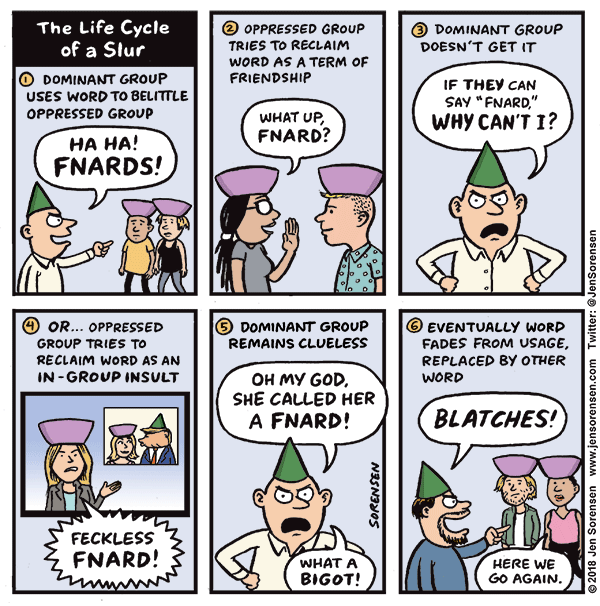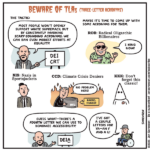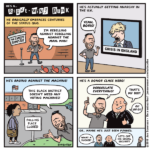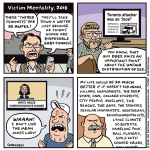The Life Cycle of a Slur

This week’s strip was inspired by the recent Samantha Bee controversy, in which the comedian referred to Ivanka Trump as a “feckless c-word” during a monologue about Trump’s treatment of undocumented immigrants. This came on the heels of Roseanne having her show canceled for making racist and anti-Semitic remarks on Twitter. Many on the right demanded similar consequences for Bee, who later apologized. But the two incidents were not the same. As I tweeted the other day:
Samantha Bee, a woman, calling a white supremacist wannabe-oligarch’s enabling daughter the c-word is punching up. A white person calling a black person an ape and spreading anti-Semitic conspiracy theories is punching down, historical abomination-style.
When it comes to slurs, it’s not about the word itself — it’s about the context. The meaning changes depending on who’s using the word, and who they’re talking about. Samantha Bee is probably the most feminist personality on TV right now. When she drops a c-bomb in the service of criticizing a woman who is complicit in oppression, it may be a crude insult — but it’s not sexist.
That said, I try to avoid using language in this way in my own work, since there’s too much room for misinterpretation. And there are reasonable debates to be had about the merits of certain types of reclaiming; I’ve even drawn cartoons in the past about the dangers of embracing your opponents’ insults (“tree hugger” being one example that hasn’t helped reframe the debate, in my opinion). HOWEVER! I’m not “making excuses” for Sam Bee simply because I’m a fan. Had she said something genuinely supportive of patriarchy, I’d criticize it. I think Rebecca Traister gets it right here:
It is true that in her critique of Ivanka Trump, Bee used an expletive that is explicitly misogynistic; it is wholly reasonable to object to the word cunt for feminist reasons. It is also reasonable and worthwhile to consider why a term for female anatomy has become such a potent pejorative; why does a word that means vagina also mean “very bad person”? That’s a valid question, but it’s crucial to consider it in this context. Bee was not reinforcing or replicating the crude harm that “cunt” has been used to inflict historically: the patriarchal diminishment and vilification of women. In fact, Bee was using it to criticize a woman precisely because that woman is acting on behalf of that patriarchy, one that systematically diminishes women, destroys families, and hurts children.
Given that we can’t even pass the Equal Rights Amendment, it’s probably a stretch to expect that many people get these subtleties. But one thing that is clear: we can safely dismiss the performative outrage from those who never gave a damn about misogyny until now.




